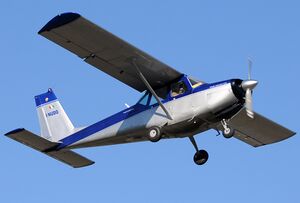Engineering:Partenavia Oscar
| Oscar / Charlie | |
|---|---|

| |
| Role | Light tourer |
| Manufacturer | Partenavia |
| Designer | Luigi Pascale |
| First flight | 2 April 1965 |
| Introduction | 1967 |
| Primary user | Aero Club d'Italia |
| Number built | 312 |
| Developed from | Partenavia Fachiro |
| Variants | Vulcanair V1.0 |
The Partenavia P.64B/P.66B Oscar is an Italian two/four-seat, single-engined, high-wing monoplane built by Partenavia.
Development
Developed as an all-metal version of the P.57 Fachiro, the prototype was designated the P.64 Fachiro III and first flew on 2 April 1965. Improvements were made to the design, mainly to the rear fuselage to fit a panoramic rear window, and now renamed the P.64B Oscar B it first flew in 1967. Also known as the Oscar 180 powered by a 180 hp Lycoming O-360-A1A piston engine, a 200 hp version (with a Lycoming O-360-A1B engine) was known as the Oscar-200. Twenty-one aircraft were delivered to South Africa and assembled by AFIC (Pty) Limited and marketed as the AFIC RSA 200 Falcon.
In January 1976, the company flew a new fully aerobatic version, the P.66C Charlie, and 96 were built, mainly for the Aero Club d'Italia.
Variants
- P.64 Fachiro III - Prototype, one built.
- P.64B Oscar B - Production aircraft with cut-down rear fuselage and 180 hp (134 kW) Lycoming engine, 64 built.
- P.64B Oscar 180 - Marketing name for the Oscar B.
- P.64B Oscar 200 - 200 hp version of the Oscar B, 9 built.
- P.66B Oscar 100 - Two-seat version with 100 hp (75 kW) Lycoming engine, 80 built.
- P.66B Oscar 150 - Three-seat version with 150 hp (112 kW) Lycoming O-320 engine, 50 built.
- P.66C Charlie - Four-seat aerobatic version of the P.66B with 160 hp Lycoming engine, 107 built.
- P.66D Delta - P.66B with minor changes, one built.
- P.66T Charlie - Two-seat trainer version of the P.66C, one built.
- AFIC RSA 200 Falcon - South-African version of the P.64.
Operators
 Italy
Italy
- Italian State Police[1]
- South Africa
Specifications (P.66C-160 Charlie)
Data from Jane's All The World's Aircraft 1982-83[2]
General characteristics
- Crew: 1
- Capacity: 3 pax
- Length: 7.24 m (23 ft 9 in)
- Wingspan: 9.986 m (32 ft 9 in)
- Height: 2.77 m (9 ft 1 in)
- Wing area: 13.4 m2 (144 sq ft)
- Aspect ratio: 7.45
- Airfoil: NACA 63A515[3]
- Empty weight: 600 kg (1,323 lb)
- Max takeoff weight: 990 kg (2,183 lb)
- Fuel capacity: 162 L (43 US gal; 36 imp gal) fuel ; 7.5 L (2 US gal; 2 imp gal) oil
- Powerplant: 1 × Lycoming O-320-H2AD 4-cylinder air-cooled horizontally-opposed piston engine, 119 kW (160 hp)
- Propellers: 2-bladed Hoffmann Propeller HO 23-183.150, 1.88 m (6 ft 2 in) diameter fixed-pitch propeller
Performance
- Maximum speed: 241 km/h (150 mph, 130 kn)
- Cruise speed: 218 km/h (135 mph, 118 kn) Maximum, at 75% power and 1,980 m (6,496 ft)
- 206 km/h (128 mph; 111 kn) Economical, at 65% power and 2,745 m (9,006 ft)
- Stall speed: 98.5 km/h (61.2 mph, 53.2 kn) flaps up
- 93 km/h (58 mph; 50 kn) take-off flap
- 82 km/h (51 mph; 44 kn) landing flap
- Range: 854 km (531 mi, 461 nmi) at Max cruise with reserve fuel
- 975 km (606 mi; 526 nmi) at Economical cruise with reserve fuel
- Endurance: 3 hours 54 minutes at Max cruise
- 4 hours 44 minutes at Economical cruise
- Service ceiling: 4,570 m (14,990 ft)
- Rate of climb: 4.82 m/s (949 ft/min)
- Wing loading: 73.88 kg/m2 (15.13 lb/sq ft)
- Power/mass: 0.0734 hp/lb (0.1207 kW/kg)
- Take-off run: 245 m (804 ft)
- Take-off distance to 15 m (49 ft): 420 m (1,378 ft)
- Landing run: 150 m (492 ft)
- Landing distance from 15 m (49 ft): 350 m (1,148 ft)
See also
Related development
Aircraft of comparable role, configuration and era
References
- ↑ Hatch Air Pictorial June 1985, p. 207.
- ↑ Taylor 1982, p.143.
- ↑ Lednicer, David. "The Incomplete Guide to Airfoil Usage". https://m-selig.ae.illinois.edu/ads/aircraft.html.
- The Illustrated Encyclopedia of Aircraft (Part Work 1982-1985). Orbis Publishing.
- Hatch, Paul F. (June 1985). "Air Forces of the World: Italian State Police (Polizia di Stato)". Air Pictorial 47 (6): 207.
- Simpson, R.W. (1991). Airlife's General Aviation. Shrewsbury, England: Airlife Publishing. ISBN 1-85310-194-X.
- Taylor, John W. R. (1982). Jane's All The World's Aircraft 1982-83. London: Jane's Yearbooks. p. 143. ISBN 0-7106-0748-2.
 |


